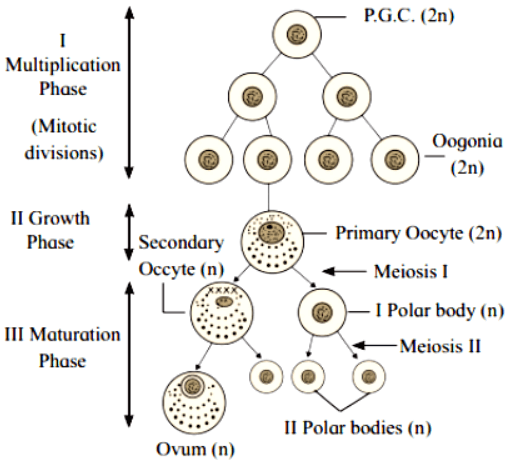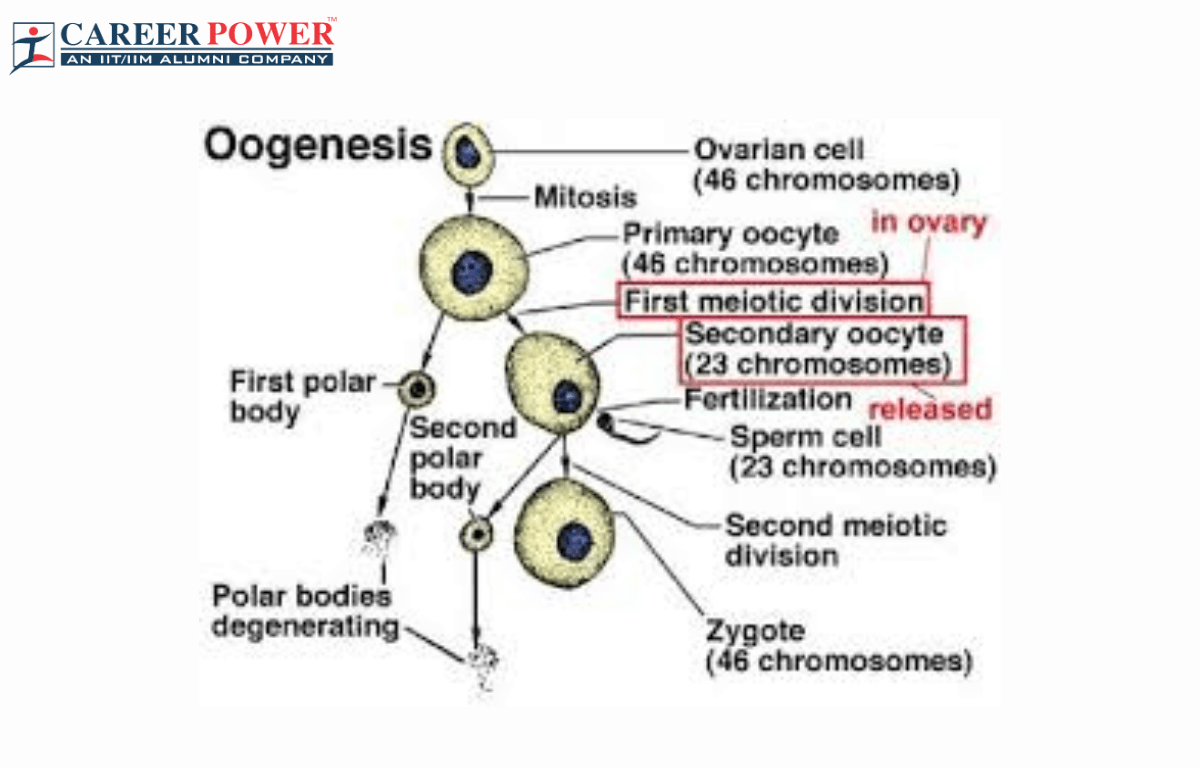Oogenesis is the specific gametogenesis process in females. It begins before birth, with cells dividing and maturing into eggs (ova) during a woman’s lifetime. Unlike in males, where new sperm are continuously produced, females are born with a set number of eggs, which mature and are released during the menstrual cycle. Gametogenesis is also counted as one of the important topics in Biology. Here we have briefly discussed the whole process of Oogenesis.
Define Oogenesis
Oogenesis is the process by which female germ cells, called oocytes, develop into mature eggs (ova) produced in the ovaries. It is a crucial part of the female reproductive system and begins before a female is even born. During oogenesis, specialized cells in the ovaries called oogonia undergo a series of divisions and differentiations to eventually form mature eggs or ova. It occurs in the outermost layer of the ovary.
The process of oogenesis involves several stages, including the multiplication and growth of oogonia, meiosis (a type of cell division that reduces the chromosome number by half), and maturation of the egg cell. Unlike in males, where new sperm are continuously produced throughout life, females are born with a finite number of ova, and this supply gradually depletes over time. Oogenesis is essential for sexual reproduction, as mature eggs can be fertilized by sperm cells to form a new organism during sexual intercourse.
Phases of Oogenesis
The formation of the ovum starts before birth during 6-7 months of pregnancy. The process of oogenesis occurs in the ovaries or the female gonads. Oogenesis is mainly made up of three phases:
- Multiplication Phase
- Growth Phase
- Maturation Phase

Multiplication Phase
The multiplication phase is also known as the Proliferative phase. During fetal development, the primary germ cell of germinal epithelium divides to form millions of oogonia (precursor cells) or egg mother cells in each ovary. Some of these oogonia transform into primary oocytes.
Growth Phase
The growth phase in oogenesis refers to the period during which primary oocytes, which are formed from oogonia, undergo maturation. This phase begins before a female is born and continues throughout her life until menopause. The growth phase is essential for preparing the primary oocytes for potential fertilization. Only a small number of these oocytes will be ovulated and have the chance to develop into a mature egg during a woman’s reproductive years.
Maturation Phase
The maturation phase in oogenesis refers to the final stages of the development of an oocyte (egg cell) from its initial state as a primary oocyte to a mature, fertilization egg. This phase includes the processes of meiosis I and meiosis II, which ultimately lead to the formation of a mature ovum. The maturation phase is crucial for producing a functional and genetically viable egg cell, ensuring the continuation of the species through sexual reproduction.
Stages of Oogenesis
Oogenesis, the process of egg cell development, occurs in several stages. It is important to note that oogenesis is a continuous process that occurs over a female’s lifetime, but the stages mentioned below represent the key developmental milestones in the formation of a mature egg cell.
| Different Stages of Oogenesis | |
| Oogenesis Stages | Description |
| Fetal Stage | Oogonia (precursor cells) multiply through mitosis. |
| Primary Oocyte | Some oogonia transform into primary oocytes before birth. These are arrested in prophase I of meiosis. |
| Puberty | At puberty, a primary oocyte resumes meiosis I, forming a secondary oocyte and a polar body. The secondary oocyte is arrested in metaphase II. |
| Ovulation | A mature secondary oocyte is released from the ovary. If fertilized, it continues with meiosis II. |
| Fertilization | If fertilized, the secondary oocyte completes meiosis II, forming a mature ovum and another polar body. |
| Polar Bodies | Small cells containing extra genetic material; produced during miosis I and meiosis II but do not develop further. |
| Maturation | The mature ovum is a large, nutrient-rich cell ready for fertilization and early embryonic development. |
Process of Oogenesis
Oogenesis is the process by which female germ cells, called oogonia, develop into mature eggs (or ova). Remember that oogenesis is a complex process influenced by various hormonal signals in a female’s life starting before birth and continuing until menopause. Here is a step-by-step overview of oogenesis process.
- Proliferation: During fetal development, oogonia undergo mitosis, increasing their numbers.
- Primary Oocyte Formation: Some oogonia differentiate into primary oocytes. This happens before a female is born. These primary oocytes are arrested in prophase I of meiosis.
- Puberty: After reaching puberty, during each menstrual cycle, some primary oocytes are stimulated to resume meiosis I, resulting in two unequal cells: a smaller polar body and a larger secondary oocyte (haploid, with 23 chromosomes).
- Meiosis II: The secondary oocyte is arrested in metaphase II. It will only complete meiosis II if it is fertilized by a sperm cell.
- Ovulation: During the menstrual cycle, the mature secondary oocyte is released from the ovary in response to hormonal signals. If it is not fertilized within a certain timeframe, it disintegrates.
- Fertilization: If a sperm cell penetrates the secondary oocyte, it triggers meiosis II. The oocyte divides again, forming another polar body and a mature ovum (or egg), which has the full complement of chromosomes.
- Formation of Polar Bodies: The polar bodies formed during meiosis I and meiosis II are small cells that do not develop into visible eggs. They contain the extra genetic material that is discarded during oogenesis.
- Maturation: The mature ovum contains the necessary nutrients and organelles to support early embryonic development.



 50 Vegetables Name for Kids in English a...
50 Vegetables Name for Kids in English a...
 Food Chain: Definition, Types, Examples,...
Food Chain: Definition, Types, Examples,...
 Human Respiratory System: Definition, Di...
Human Respiratory System: Definition, Di...













